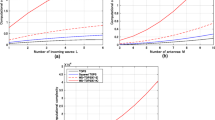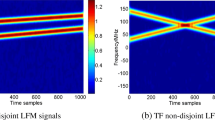Abstract
In this paper, we discuss some issues relevant to frequency and direction of arrival (DOA) tracking problems. First, we develop a linear Frequency Modulated (FM) signal model for accurately describing windowed, slowly time varying narrowband signals that typically occur in tracking problems. We then derive first order bias expressions for the peak locations of a Discrete Time Fourier Transform (DTFT) spectrum of a windowed, slowly time varying linear FM signal. We also show that Forward-Backward (FB) averaging is generally inappropriate for nonstationary data, but that it is appropriate when applied to tracking the frequencies of windowed, slowly time varying narrowband signals. A major motivation for using FB averaging is to increase the efficiency of subspace based frequency/DOA estimation in tracking problems. Finally, simulations confirm our first order bias expressions, and show that FB averaging does not significantly alter (or degrade) the time varying MUSIC based frequency estimation performance over that of Forward only averaging.
Similar content being viewed by others
References
E.M. Dowling, L.P. Ammann, and R.D. DeGroat, “A TQR-interaction based SVD for real time angle and frequency tracking”,IEEE Transactions on Signal Processing, pp. 914–925, April 1994.
T. Wigren and A. Eriksson, “Accuracy aspects of DOA and angular velocity estimation in sensor array processing,”IEEE Signal Processing Letters, Vol. 2, No. 4, pp. 60–62, April 1995.
O.M. Macchi and N.J. Bershad, “Adaptive recovery of a chirped sinusoid in noise, Part 2: Performance of the Ims algorithm,” March 1991.
N.J. Bershad and O.M. Macchi, “Adaptive recovery of a chirped sinusoid in noise, Part 2: Performance of the lms algorithm”,IEEE Trans SP Vol SP 39, pp. 595–602, March 1991.
J.R. Zeidler, K.-C. Chew, T. Soni, and W.H. Ku, “Tracking model of an adaptive lattice filter for a linear chirp fm signal in noise,”IEEE Trans. SP, Vol. SP 42, pp. 1939–1951, Aug. 1994.
J.R. Zeidler, T. Soni, and W.H. Ku, “Behavior of the partial correlation coefficients of a least squares lattice filter in the presence of a nonstationary chirp input’,IEEE Trans. SP Vol SP 42, pp. 852–863, April 1995.
R. Schmidt, “Multiple emitter location and signal parameter estimation,”IEEE Trans. Anternnas and Propag., Vol. AP-34, March dy1986.
R.D. DeGroat and D.A. Linebarger, “Eigen and subspace updating with forward-backward averaging,” in26th Annual Asilomar Conference on Signals, Systems, and Computers pp. 581–585, Oct. 1992.
D.A. Linebarger, R.D. DeGroat, and E.M. Dowling, “Efficient direction finding methods employing forward/backward averaging,”IEEE Tr. Sp., Vol. 42, No. 8, pp. 2136–2145, Aug. 1994.
D.A. Linebarger, R.D. DeGroat, E.M. Dowling, P. Stoica, and G. Fudge, “Incorporating a priori information into MUSIC-algorithms and analysis,”Signal Processing, Vol. 46, No. 1, pp. 85–104, 1995.
R.D. DeGroat and R.A. Roberts, “Efficient, numerically stabilized rank-one eigenstructure updating”,IEEE Trans. ASSP, Vol. ASSP-38, No. 2, pp 301–316, Feb. 1990.
M. Moonen, P. VanDooren, and J. Vanderwalle, “A note on efficient, numerically stabilized rank-one eigenstructure updating”,IEEE Trans. Signal Processing, Vol. ASSP-39, No. 8, pp. 1913–1914, Aug. 1991.
R.D. DeGroat, “Author's reply to a note on efficient, numerically stabilized rank-one eigenstructure updating,”IEEE Trans. Signal Processing, Vol. ASSP-39, No. 8, pp. 1913–1914, Aug. 1991.
A. Edelman and G.W. Stewart, “Scaling for orthogonality,”IEEE Trans. Signal Processing, Vol. SP-41, No. 4, pp. 1676–1677, April 1993.
R.D. DeGroat, “Non-iterative subspace tracking”,IEEE Trans. Sig. Proc. Vol. SP-40, No. 3, pp. 571–577, March 1992.
A.J. Barabell, “Improving the resolution of eigenstrucure-based direction-finding algorthms”,Proceedings ICASSP, pp. 336–339, 1983.
N.L. Owsley, “A standardized test case (STC) for sensor array processor evaluation,” inProc. IEEE Oceans'91 Conference, pp. 594–601, 1991.
A.C. Barthelemy and N.L. Owsley, “Sensor array evaluation with a standardized test case (STC),”Proc. of the Twentyfifth Asilomar Conference on Signals, Systems and Computers, pp. 898–902, 1991.
G.H. Golub and C.F. VanLoan,Matrix Computations, 2nd ed., John Hopkins Unviersity Press, Baltimore, Maryland, 1989.
Author information
Authors and Affiliations
Additional information
This research was supported in part by the National Science Foundation Grant MIP-9203296 and Texas Advanced Research Program Grant 009741-022 and 009741-065.
Rights and permissions
About this article
Cite this article
Degroat, R.D., Dowling, E.M. & Linebarger, D.A. Bias correction and forward-backward averaging in frequency/DOA tracking problems. J VLSI Sign Process Syst Sign Image Video Technol 14, 93–105 (1996). https://doi.org/10.1007/BF00925271
Received:
Revised:
Published:
Issue Date:
DOI: https://doi.org/10.1007/BF00925271




